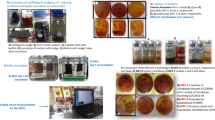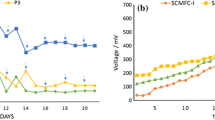Abstract
In this study, bacteria from a microbial fuel cell (MFC) and isolates were evaluated on their Fe3+ reduction capability at different concentrations of iron using acetate as the sole source of carbon. The results demonstrated that the planktonic cells can reach an iron reduction up to 60% at 27 mmol Fe3+. Azospira oryzae (µ 0.89 ± 0.27 d−1) and Cupriavidus metallidurans CH34 (µ 2.34 ± 0.81 d−1) presented 55 and 62% of Fe3+ reduction, respectively, at 16 mmol l−1. Enterobacter bugandensis (µ 0.4 ± 0.01 d−1) 40% Fe3+ at 27 mmol l−1, Citrobacter freundii ATCC 8090 (µ 0.23 ± 0.05 d−1) and Citrobacter murliniae CDC2970-59 (µ 0.34 ± 0.02 d−1) reduced Fe3+ in ~ 50%, at 55 mmol l−1. This is the first report on these bacteria on a percentage of iron reduction. These results may be useful for anode design to contribute to a higher energy generation in MFCs.




Similar content being viewed by others
References
Abbas SZ, Rafatullah M, Ismail N, Shakoori F (2018) Electrochemistry and microbiology of microbial fuel cells treating marine sediments polluted with heavy metals. RSC Adv 8:18800. https://doi.org/10.1039/c8ra01711e
Banin E, Vasil ML, Greenberg EP (2005) Iron and Pseudomonas aeruginosa biofilm formation. PNAS 102:11076–11081
Baranitharan E, Maksudur RK, Yousuf A et al (2015) Enhanced power generation using controlled inoculum from palm oil mill effluent fed microbial fuel cell. Fuel 143:72–79. https://doi.org/10.1016/j.fuel.2014.11.030
Becerril-Varela K, Serment-Guerrero JH, Manzanares-Leal GL et al (2021) Generation of electrical energy in a microbial fuel cell coupling acetate oxidation to Fe3+ reduction and isolation of the involved bacteria. World J Microbiol Biotechnol. https://doi.org/10.1007/s11274-021-03077-4
Deomedesse-Minari G, Maria Saran L, Lima Constancio MT et al (2020) Bioremediation potential of new cadmium, chromium, and nickel-resistant bacteria isolated from tropical agricultural soil. Ecotoxicol Environ Safety 204:111038. https://doi.org/10.1016/j.ecoenv.2020.111038
Esther J, Sukla LB, Pradhan N et al (2015) Fe (III) reduction strategies of dissimilatory iron reducing bacteria. Korean J Chem Eng 32(1):1–14. https://doi.org/10.1007/s11814-014-0286-x
Fan YY, Li BB, Yang ZC et al (2018) Abundance and diversity of iron reducing bacteria communities in the sediments of a heavily polluted freshwater lake. Appl Microbiol Biotechnol 102:10791–10801. https://doi.org/10.1007/s00253-018-9443-1
González-Paz JR, Monterrubio-Badillo MC, Ordaz A et al (2022) Influence of Fe2+ and Fe3+ on the performance and microbial community composition of a MFC inoculated with sulfate- reducing sludge and acetate as electron donor. J Chem. https://doi.org/10.1155/2022/5685178
Huang J, Zhu N, Cao Y et al (2015) Exoelectrogenic bacterium Phylogenetically related to Citrobacter freundii, isolated from anodic biofilm of a microbial fuel cell. Appl Biochem Biotechnol 175:1879–1891. https://doi.org/10.1007/s12010-014-1418-9
Kikuti-Mancílio LB, Augusto-Ribeiro G, Mendes-Lopes E et al (2020) Unusual microbial community and impact of iron and sulfate on microbial fuel cell ecology and performance. Curr Res Biotechnol 2:64–73. https://doi.org/10.1016/j.crbiot.2020.04.001
Kwon MJ, O’Loughlin EJ, Boyanov MI et al (2016) Impact of organic carbon electron donors on microbial community development under iron-and sulfate-reducing conditions. PLoS ONE 11:1–22. https://doi.org/10.1371/journal.pone.0146689
Liu L, Lee DJ, Wang A et al (2016) Isolation of Fe(III)-reducing bacterium, Citrobacter sp. LAR-1, for startup of microbial fuel cell. Int J Hydrog Energy 41:4498–44503. https://doi.org/10.1016/j.ijhydene.2015.07.072
Liu Q, Yang Y, Mei X et al (2018) Response of the microbial community structure of biofilms to ferric iron in microbial fuel cells. Sci Tot Environ 631–632:695–701. https://doi.org/10.1016/j.scitotenv.2018.03.008
Liu H, Wang H (2016) Characterization of Fe (III)-reducing enrichment culture and isolation of Fe (III)—reducing bacterium Enterobacter sp. L6 from marine sediment. J Biosci Bioeng 122:92–96. https://doi.org/10.1016/j.jbiosc.2015.12.014
Logan BE, Rossi R, Ragab A et al (2019) Electroactive microorganisms in bioelectrochemical systems. Nature Rev Microbiol 17:307–319. https://doi.org/10.1038/s41579-019-0173-x
Lovley DR, Fraga JR, Blunt-Harris EL et al (1998) Humic substances as a mediator for microbially catalyzed metal reduction. Acta Hydrochimica Hydrobiologica 26:152–157
Lovley DR, Holmes DE, Nevin KP (2004) Dissimilatory Fe (III) and Mn (IV) reduction. Adv Microbiol Physiol 49(2):219–286. https://doi.org/10.1016/S0065-2911(04)49005-5
Martins M, Faleiro ML, Barros RJ et al (2009) Characterization and activity studies of highly heavy metal resistant sulphate-reducing bacteria to be used in acid mine drainage decontamination. J Hazard Mat 166:706–713. https://doi.org/10.1016/j.jhazmat.2008.11.088
Müller JB, Ramos DT, Larose C et al (2017) Combined iron and sulfate reduction biostimulation as a novel approach to enhance BTEX and PAH source-zone biodegradation in biodiesel blend-contaminated groundwater. J Hazard Mater 326:229–236. https://doi.org/10.1016/j.jhazmat.2016.12.005
Pierra M, Carmona-Martínez AA, Trably E et al (2015) Microbial characterization of anode-respiring bacteria within biofilms developed from cultures previously enriched in dissimilatory metal-reducing bacteria. Bioresour Technol 195:283–287. https://doi.org/10.1016/j.biortech.2015.07.010
Schmidta N, Pageb D, Tiehma A (2017) Biodegradation of pharmaceuticals and endocrine disruptors with oxygen, nitrate, manganese (IV), iron (III) and sulfate as electron acceptors. J Cont Hydrol 203:62–69. https://doi.org/10.1016/j.jconhyd.2017.06.007R
Tian T, Yu HQ (2020) Iron-assisted biological wastewater treatment: synergistic effect between iron and microbes. Biotechnol Adv 44:107610. https://doi.org/10.1016/j.biotechadv.2020.107610
Venkidusamy K, Hari AR, Megharaj M (2018) Petrophilic, Fe(III) reducing exoelectrogen citrobacter sp. KVM11, isolated from hydrocarbon fed microbial electrochemical remediation systems. Front Microbiol 9:349. https://doi.org/10.3389/fmicb.2018.00349
Viollier E, Inglett PW, Hunter K et al (2000) The ferrozine method revisited: Fe(II)/ Fe(III) determination in natural waters. Appl Geochem 15:785–790
Wang J, Bi S, Chen Y et al (2020) Electron transfer involved in bio-Pd (0) synthesis by Citrobacter freundii at different growth phases. Ecotoxicol Environ Saf 190:110124
Wang Z, Ma J, Xu Y et al (2013) Power production from different types of sewage sludge using microbial fuel cells: a comparative study with energetic and microbiological perspectives. J Power Sources 235:280–288
Zhang J, Zhang Y, Liu B et al (2014) A direct approach for enhancing the performance of a microbial electrolysis cell (MEC) combined anaerobic reactor by dosing ferric iron: enrichment and isolation of Fe (III) reducing bacteria. Chem Eng J 248:223–229. https://doi.org/10.1016/j.cej.2014.02.102
Zhang J, Zhang Y, Quan X et al (2013) Effects of ferric iron on the anaerobic treatment and microbial biodiversity in a coupled microbial electrolysis cell (MEC)—anaerobic reactor. Water Res 47:5719–5728. https://doi.org/10.1016/j.watres.2013.06.056
Zheng S, Wang B, Li Y et al (2017) Electrochemically active iron (III)-reducing bacteria in coastal riverine sediments. J Basic Microbiol 57:1045–1054. https://doi.org/10.1002/jobm.201700322
Acknowledgements
The authors are grateful for the financial support provided by Secretaría de Investigación y Posgrado (SIP) Instituto Politécnico Nacional and CONACYT. Thanks to Vanessa León-Ortega, Miriam L. Carbajal and Evelyn Guadalupe López Ledezma for her technical assistance.
Funding
Secretaría de Investigación y Posgrado (SIP-IPN) Grants number 20211208—20221270, recipient: G—B, C., and the graduate scholarships (CONACYT) awarded to J. R. G—P and K. B—V.
Author information
Authors and Affiliations
Contributions
González-Paz JR and Becerril-Varela K conducted the experimental work and prepared drafts for the figures and Table 1. Guerrero-Barajas C worked on the conceptualization of the work, funding, revision of data, wrote the manuscript and prepared the final figures and supplementary material. All authors reviewed the manuscript.
Corresponding author
Ethics declarations
Conflict of interest
The authors declare that they do not have any conflict of interest.
Additional information
Communicated by Erko Stackebrandt.
Publisher's Note
Springer Nature remains neutral with regard to jurisdictional claims in published maps and institutional affiliations.
Supplementary Information
Below is the link to the electronic supplementary material.
Rights and permissions
Springer Nature or its licensor holds exclusive rights to this article under a publishing agreement with the author(s) or other rightsholder(s); author self-archiving of the accepted manuscript version of this article is solely governed by the terms of such publishing agreement and applicable law.
About this article
Cite this article
González-Paz, J.R., Becerril-Varela, K. & Guerrero-Barajas, C. Iron reducing sludge as a source of electroactive bacteria: assessing iron reduction in biofilm bacteria, planktonic cells and isolates from a microbial fuel cell. Arch Microbiol 204, 632 (2022). https://doi.org/10.1007/s00203-022-03253-6
Received:
Revised:
Accepted:
Published:
DOI: https://doi.org/10.1007/s00203-022-03253-6




